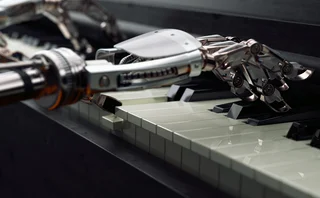An Ode to Automation
Even with the advent of blockchain, machine learning, and artificial intelligence, automation remains the technology that has revolutionized the industry.

Automation is one of those subjects people love to talk about. It doesn’t elicit confused faces or cautious questions, because people generally already know what it is. Yet, it still has the greatest potential to change the financial services industry, even more than it already has. Firms may have elements of automation deployed throughout their technology stack, but there is still so much room for evolution.
A report from FIS titled The Hunt for Growth, published in June, which surveyed 1,000 buy-side and sell-side firms, shows that there is strong demand for further trade automation, better data management and focus on digitization. The findings note that 59 percent of surveyed buy-side firms anticipate highly automated trade execution in the next three years, while 53 percent of sell-side firms are planning to meet that demand. This automation is not confined to transactions but the whole trade life-cycle, including middle- and back-office processing.
John Avery, director, client and industry engagement, derivatives utility at FIS, says much of this demand is around regulatory compliance and the need to cut costs. “The biggest challenges firms are facing are around regulation, the global political climate and of course cost-cutting which is still in place for many in the industry,” Avery says. “But we see that being committed to technology, those who are best prepared to meet those challenges with technology can continue to do well.” He adds that demand for automation, to reduce manual input so employees can focus on more value-added tasks, reinforces that message.
It’s not just down to a desire to change, of course. Regulatory reform is encouraging many firms to look at market segments in different ways, and at using resources more intelligently as a result, on a firm-wide basis rather than just in response to specific issues. Part of this is through investment in technology to further cut costs. “What is interesting is that there are some firms that want to take advantage of regulatory change,” Avery says. “They will either de-emphasize or enter certain markets, but as long as they’re invested in technology they are confident they can leverage these changes and even free capital to invest in strong innovations.”
The FIS report shows how important automation still is for financial services. How fast and widespread automation within a company will be, however, greatly depends on their innovation strategy, and while more than half of sell-side and buy-side firms believe in the importance of automation, there are still barriers that prevent them from implementing these systems.
In the same way, automation is the driving force behind so many of today’s much-hyped technologies. What is artificial intelligence and machine learning, but a way to automate data processing and analysis? Isn’t blockchain just a way of automating all the back and forth that counterparties have to do for certain transactions?
Automation is so widely accepted in the financial services industry, but when phrased in certain ways, can inspire fear that robots will replace people. The same people who express that fear also complain that much of the grunt work in finance is manual. If that pressure is relieved and the skilled people in all areas of the financial services industry are freed up to focus on their core work, who knows where the industry will go?
Inspiration
This ode to automation was inspired by podcast I heard a few weeks ago, focusing on the history of the humble spreadsheet. Microsoft Excel, today’s most widely-used spreadsheet program, was conceived as a means to automate and replace the manually intensive task of writing down numbers on a sheet of paper. This also shows the ephemeral nature of automation. We went from celebrating the computerized spreadsheet to figuring out ways to phase it out completely, in a few short years.
The definition of automation is ever-changing, evolving alongside the technology and processes it augments. In the future, it’s likely that today’s brave new frontier of automation might seem as quaint as Excel is starting to seem today. Perhaps then, there will be odes to AI appearing in the pages of this magazine by columnists who look at what we’re covering today with something akin to nostalgia.
Only users who have a paid subscription or are part of a corporate subscription are able to print or copy content.
To access these options, along with all other subscription benefits, please contact info@waterstechnology.com or view our subscription options here: https://subscriptions.waterstechnology.com/subscribe
You are currently unable to print this content. Please contact info@waterstechnology.com to find out more.
You are currently unable to copy this content. Please contact info@waterstechnology.com to find out more.
Copyright Infopro Digital Limited. All rights reserved.
As outlined in our terms and conditions, https://www.infopro-digital.com/terms-and-conditions/subscriptions/ (point 2.4), printing is limited to a single copy.
If you would like to purchase additional rights please email info@waterstechnology.com
Copyright Infopro Digital Limited. All rights reserved.
You may share this content using our article tools. As outlined in our terms and conditions, https://www.infopro-digital.com/terms-and-conditions/subscriptions/ (clause 2.4), an Authorised User may only make one copy of the materials for their own personal use. You must also comply with the restrictions in clause 2.5.
If you would like to purchase additional rights please email info@waterstechnology.com
More on Trading Tech
As outages spread, it’s time to rethink how we view infrastructure technology
Waters Wrap: First AWS and then Azure. And these are only the most recent of significant outages. Anthony says a change is needed when it comes to calculating server migrations.
LLM firms come for finance, BMLL gets bought, LSEG users get Preqin feeds, and more
The Waters Cooler: Tradeweb completes fully electronic RFM swaptions trade, IBM cashes in on digital asset mania, and more frights and delights in this week’s news roundup.
TMX’s CEO wonders if tokenization is a ‘solution looking for a problem’
While acknowledging the potential of tokenizing securities, John McKenzie said regulators shouldn’t move too fast, and let customer demand drive adoption.
Bolsa Mexicana embarks on multi-year modernization project
Latin America’s second largest exchange is embracing cloud and upgrading its infrastructure in a bid to bolster its global standing, says CEO.
S&P’s $1.8 billion buy, an FIA restructure, a tokenization craze, and more
The Waters Cooler: CAIS creates CAISey, BNY deploys EquiLend, and more in this week’s news roundup.
Bloomberg integrates AI summaries into Port
One buy-side user says that while it’s still early for agentic tools, they’re excited by what they’ve seen so far.
Larry Fink: ‘We need to be tokenizing all assets’
The asset manager is currently exploring tokenizing long-term investment products like iShares, with an eye on non-financial assets down the road.
Examining how adaptive intelligence can create resilient trading ecosystems
Researchers from IBM and Wipro explore how multi-agent LLMs and multi-modal trading agents can be used to build trading ecosystems that perform better under stress.







